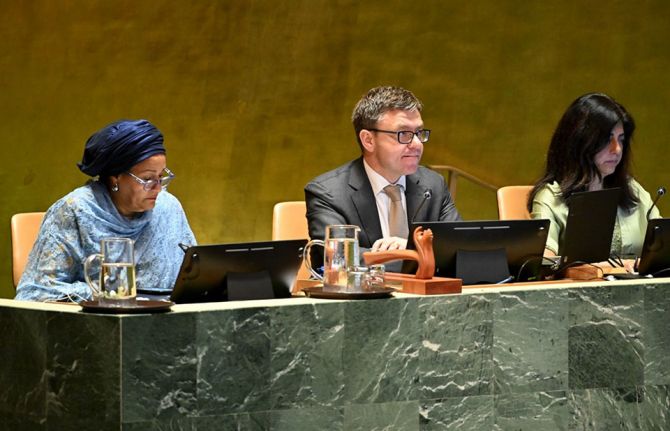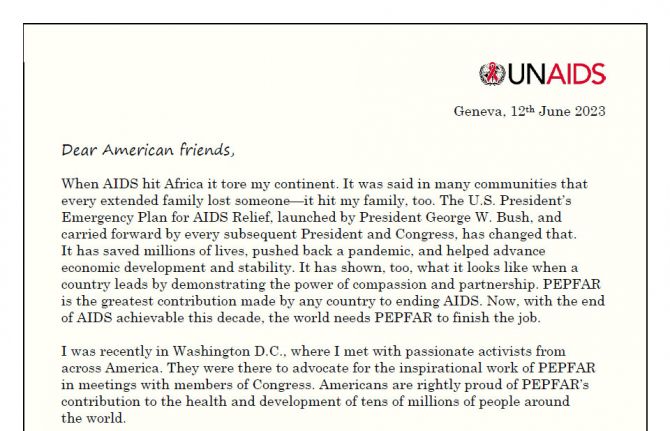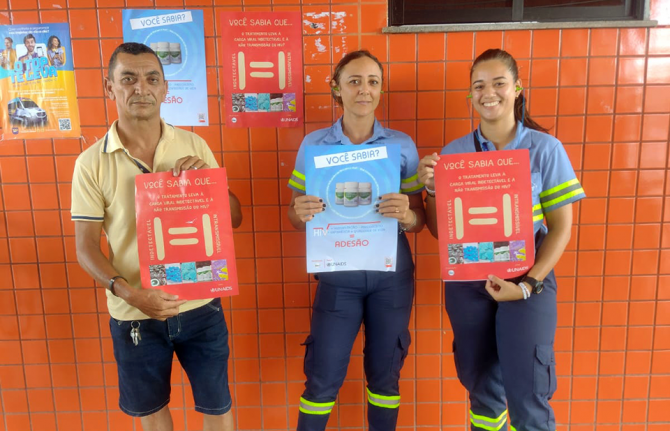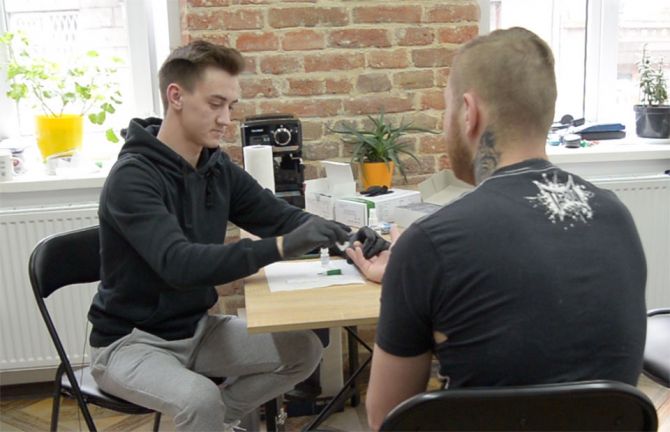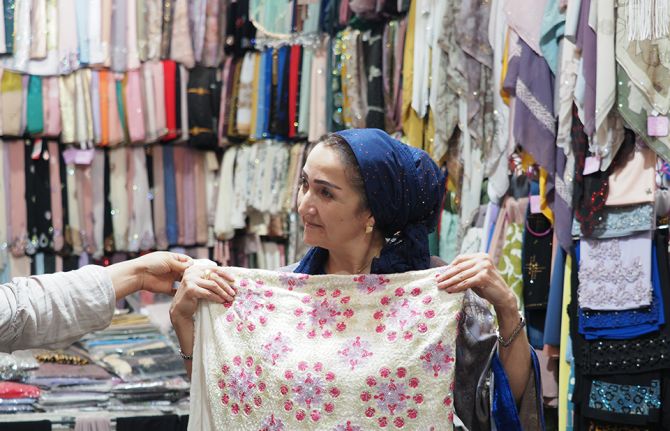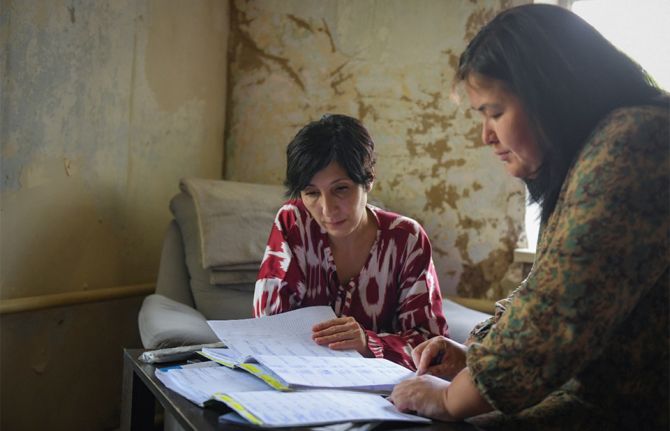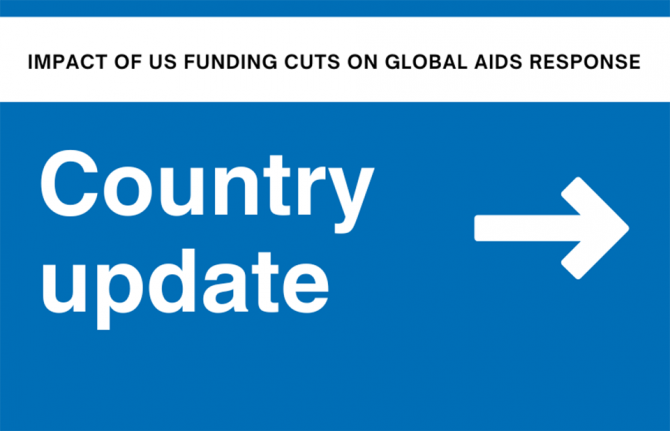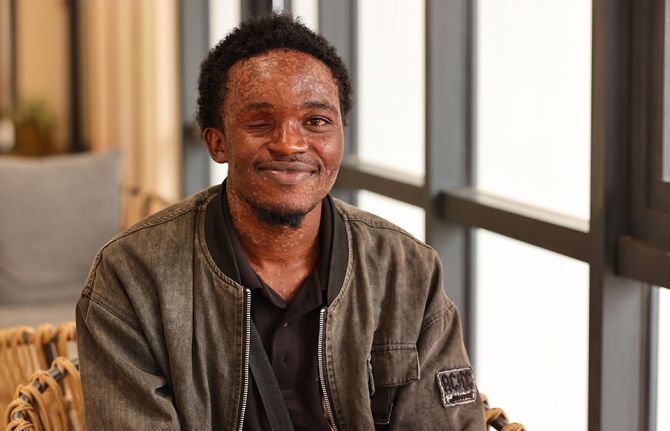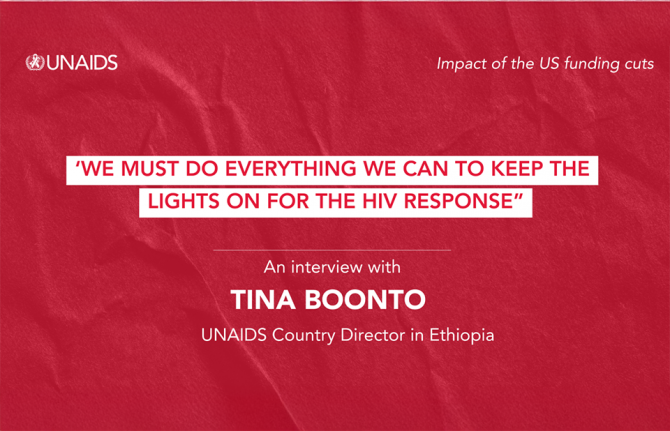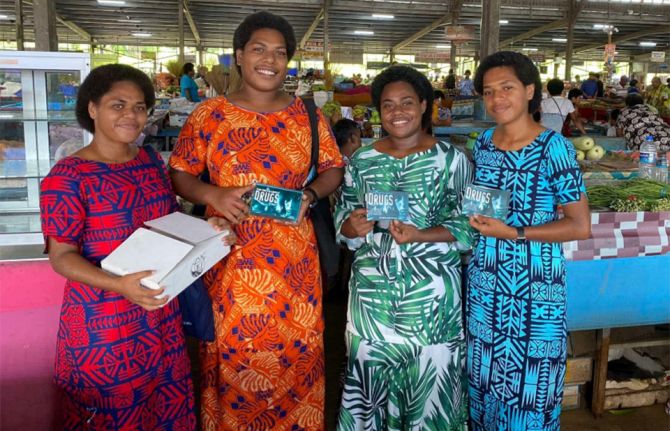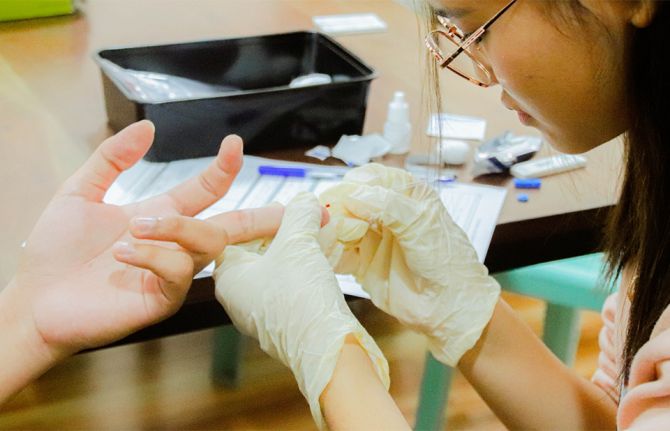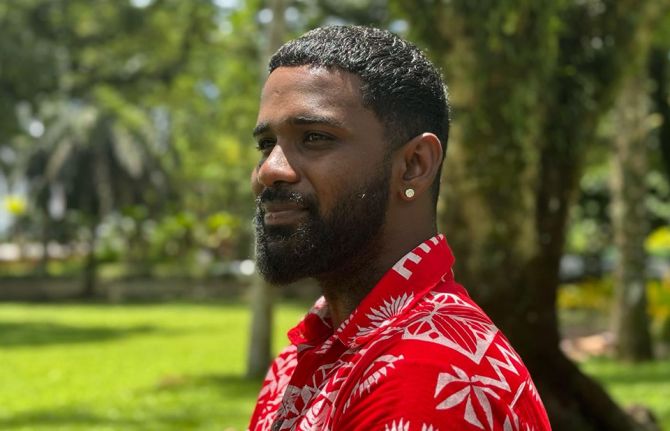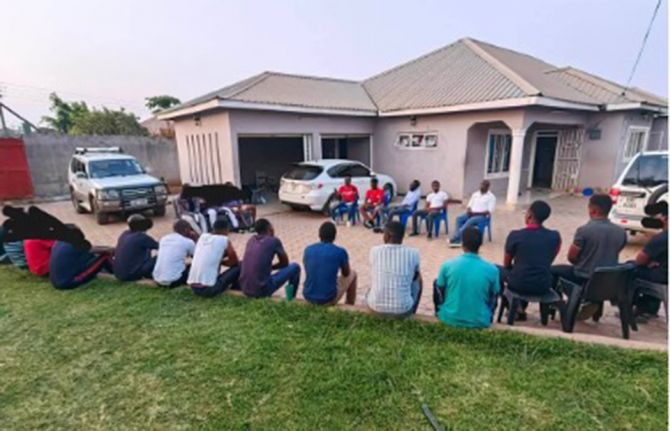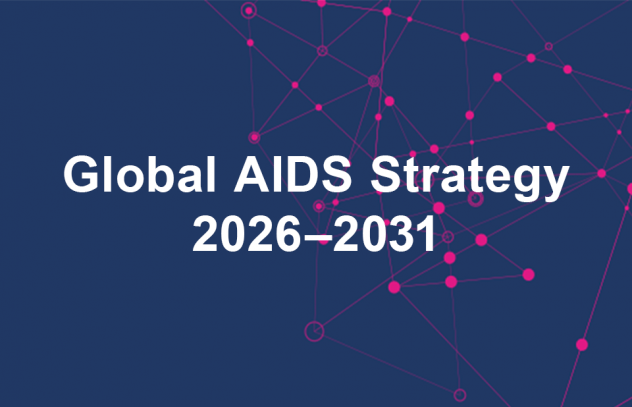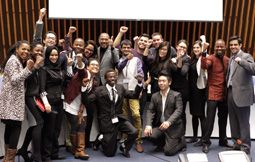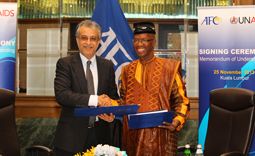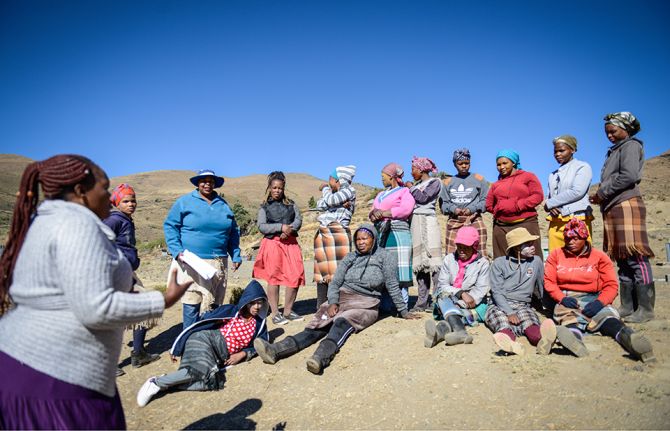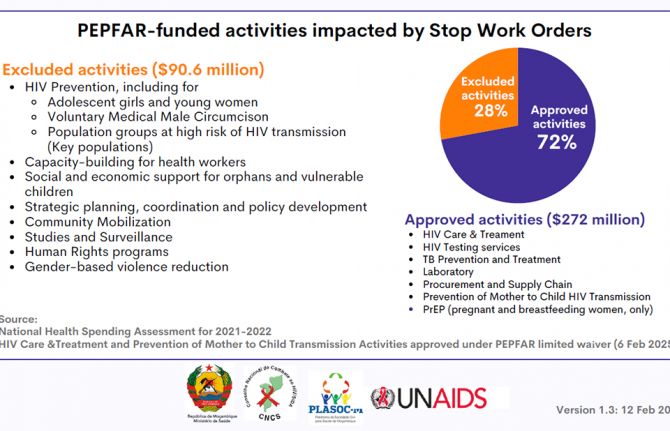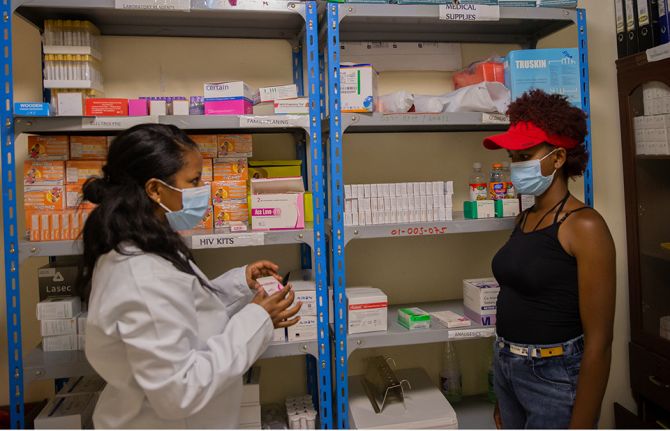
Feature Story
2008 High-Level Meeting on AIDS
15 January 2008
15 January 2008 15 January 2008The 2008 high-level meeting on AIDS will take place at the United Nations headquarters in New York on 10 - 11 June. It will review progress made in implementing the 2001 Declaration of Commitment on HIV/AIDS and the 2006 Political Declaration on HIV/AIDS.
Ahead of this high-level meeting, United Nations Secretary General Ban Ki-moon will submit a comprehensive and analytical report for consideration by Member States. The SG’s Report will be based on national reports that Member States were requested to submit to UNAIDS by 31 January 2008.
The organizational arrangements for the high-level meeting are outlined in a resolution adopted by the General Assembly on 19 December 2007. Detailed information about the plenary meetings, the thematic panel discussions, and the informal interactive civil society hearing will be provided in due course.
The high-level meeting will provide an important forum for various stakeholders, including government representatives and accredited civil society participants. Discussions are expected to focus on the progress made, challenges remaining and sustainable ways to overcome them.
Civil society engagement in the 2008 high-level meeting on AIDS
UNAIDS has been working closely with the Office of the President of the General Assembly (OPGA), the Non-Governmental Liaison Service (NGLS) and the Civil Society Support Mechanism (CSSM) to support civil society engagement in the high-level meeting and in the country level reporting processes on AIDS. The CSSM is a coalition led by the International Council of AIDS Service Organizations (ICASO) and the International Women’s Health Coalition (IWHC).
On-line civil society application form
The on-line application form was officially launched on Wednesday, 23 January 2008. It includes background information on the high-level meeting and Civil Society Hearing, as well as two different forms: a registration form for those organizations in consultative status with ECOSOC; and an accreditation form for non-ECOSOC accredited organizations wishing to attend the high-level meeting.
Civil Society Task Force
A Civil Society Task Force is currently being set up, in cooperation with the Civil Society Support Mechanism, to support UNAIDS and the OPGA in key decisions relating to the attendance and participation of civil society organizations and the private sector in the high-level meeting.
2008 High-Level Meeting on AIDS
Related links:
Related

Feature Story
Strengthening partnership: UNAIDS and the International HIV/AIDS Alliance
11 January 2008
11 January 2008 11 January 2008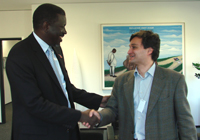
UNAIDS Director of Partnerships and
External Relations, Elhadj As Sy (L) and
Alvaro Bermejo, Executive Director of the
International HIV/AIDS Alliance (R) during
the signing of the collaboration
agreement. Geneva, 11 January 2008.
Working towards the global efforts to reach universal access to HIV prevention, treatment, care and support services for all those in need, UNAIDS has renewed its collaboration with the International HIV/AIDS Alliance.
The first agreement, which ran from 2004 to 2007, enabled strong civil society mobilisation for HIV prevention intensification, focusing particularly on empowering women to lead the AIDS response and underlining the key role of civil society in national AIDS responses.
“This is a strategic collaboration which is critical to securing greater impact, paving the way towards universal access,” said UNAIDS Director of Partnerships and External Relations, Elhadj As Sy at the signing of the renewed agreement.
The renewed partnership will focus on strengthening civil society responses to AIDS and aims to achieve the following objectives:
- Promoting direct involvement and leadership of civil society responses to HIV.– including people living with HIV and key populations.
- Promoting human rights-based responses to HIV
- Mobilising country-level public, private and civil society partnerships.
- Promoting evidence informed policy and good practice and the use of strategic information.
- Building capacity to track, monitor and evaluate country responses within a single, agreed national framework.
- Facilitating increased access to HIV prevention, treatment, care and support services.
- Facilitating access to technical and financial resources at country level.
- Facilitating and supporting the involvement of civil society and people living with HIV in planning, implementation and evaluation of national HIV strategies.
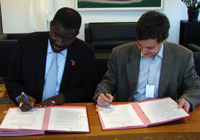
The renewed partnership will focus on
strengthening civil society responses to
AIDS.
The Alliance is a global partnership of nationally-based organisations working to support community action on HIV. These national partners help local community groups and other NGOs to take action on AIDS, and are supported by technical expertise, policy work and fundraising facilitated by the UK-based international secretariat and across the Alliance, in regional programmes and representative offices in the USA and Brussels. The Alliance also works on a range of international activities such as support for South–South cooperation, operations research, knowledge sharing, training and good practice development, as well policy analysis and advocacy.
“We are delighted with this renewed partnership that will scale up our community empowerment objectives and our joint impact on the HIV epidemic. The Alliance is committed to bring all its leverage in this partnership as part of its contribution towards universal access” said Alvaro Bermejo, the Executive Director of the Alliance.
Strengthening partnership: UNAIDS and the Interna
External links:

Feature Story
Making a difference: UNAIDS in Ukraine
08 January 2008
08 January 2008 08 January 2008
UNAIDS Country Coordinator in Ukraine,
Dr Ana Shakarishvili, speaking at the
UNAIDS global staff meeting in October
2007. Photo Credit: UNAIDS
In the first of web special series focusing on the work of UNAIDS staff at country level, http://www.unaids.org/ talks to UNAIDS Country Coordinator in Ukraine, Dr Ana Shakarishvili, about the response in the country, her role and her motivations.
In the two years that Ana Shakarishvili has been the UNAIDS Country Coordinator in Ukraine, she has seen a lot of changes. The high profile of the epidemic in the country has led to a dramatic increase in attention from donors and other partners. “Our work entails a lot of coordination between UN agencies and very active support to the UN Theme Group and Joint Team on AIDS,” says Shakarishvili. “Dealing with different agencies with different mandates, and different personalities, is an inseparable part of our lives.”
In addition to typical UNAIDS work around advocacy, coordination of the AIDS response and monitoring and evaluation, the Ukraine office provides technical support in many areas. “In other words our daily lives are enormously busy. We work overtime, there’s no day that ends early,” says Shakarishvili. “But in terms of the daily work, the greatest thing we share is real teamwork. There is an amazing level of coordination and understanding between each partner and that is something we are proud of.”

Ukraine has the most severe epidemic in
Europe. Over 400,000 people were
estimated to be living with HIV in Ukraine
in 2006. Photo Credit: UNAIDS
Ukraine has the most severe epidemic in Europe, and despite the support of government and donor programmes, the epidemic continues to grow. “It is even more concerning that we now have an unprecedented high level of resources available in the country, including two grants from the Global Fund amounting to $243 million,” says Shakarishvili. It was this conundrum that led the government’s National Coordinating Council on AIDS to request an ambitious piece of research that will evaluate the national AIDS response so far. This external evaluation, which is being coordinated by UNAIDS, will look at the work of all partners in 130 programmatic areas.
“We will have a database on what is working and what needs to be done in the future,” says Shakarishvili. “Nothing at this kind of scale has ever been done in the world. And we are really proud of that. It does put us in a rather interesting position of being responsible for pulling together efforts for this evaluation that will inform further discussions at both national and sub-national levels about what should be done next.”
The importance of this evaluation cannot be overestimated: it will feed directly into the government’s new national AIDS plan which is to be developed in 2008. The UNAIDS office and the cosponsors will play a major role in this process, helping the government to revise its national AIDS programme, including national and sub-national access targets. “We are trying to help the government develop a totally new format for the national AIDS plan which will be well-costed with clear universal access and monitoring and evaluation targets and technical support requirements,” says Shakarishvili. “Up until now the national plans were vague and were more like a framework than a clear plan.” For the first time the government plan will also include contributions of all sectors of the government as well as civil society organisations, the private sector and the donor community.
Dr Shakarishvili notes that one of the biggest challenges of working in Ukraine is the political instability that the country has experienced in recent years. Frequent elections and changes in government affect the continuity of the work and the capacity and commitment of government to make sustainable progress. “The NGOs, and civil society organisations are very mobilised and very strong especially at the national level, compared with other countries that I have seen. There is a coalition of NGOs uniting over 70 NGOs providing HIV services. But there is still somehow a level of complacency in the governmental sector. We need to encourage more and greater leadership on the issue particularly from the governmental sector. The decree of President Yushchenko that was issued just after the World AIDS Day a few weeks ago, calls for urgent scaling up of response to AIDS and increased accountability. That gives all of us much hope,” she says.
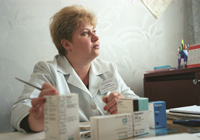
Ukraine has managed to increase the
number of people on treatment from 200
in 2004/5 to currently over 7000.
Photo Credit: UNAIDS
Despite the challenges there has been progress. “We are really seeing some differences at the national level, which is a result of joint advocacy, including that from the UN.” Aspiration also comes from daily contact with the civil society organisations that provide many HIV services in the country. “We call ourselves one big family. We work pretty much together with the government, parliamentarians, NGOs, communities of people living with HIV, development partners and the private business. Its a huge sector.”
Shakarishvili joined UNAIDS after a long career in the Centers for Disease Control and Prevention in the US. “I love it here”, she says. “Despite the large work loads, what motivates me at the moment, is this momentum to do more in Ukraine, to really make a difference by changing the way the epidemic is going and preventing that from becoming generalized. There is enormous potential that this country has, a real belief that Ukraine should be able to slow down this epidemic and achieve universal access targets in a few years.”
“There are fantastic people and competent organizations here, and we hope and trust that people and communities can make a difference. If we don’t rapidly scale up efforts and make an impact in Ukraine, there is less hope for other countries in the region, especially Russia.” On the other hand, successes in Ukraine will bring hope for others. “Ukraine has managed to increase the number of people on treatment from 200 in 2004/5 to currently over 7000, reach the coverage level of prevention programmes of 35% of injecting drug users, and finally allow the importation of methadone for substitution maintenance treatment for injecting drug users – these are the messages to the rest of the world,” says Shakarishvili.
Making a difference: UNAIDS in Ukraine
Feature stories:
Positive response to AIDS in Ukraine (17 Sept 2007)Love, live, dream: women against AIDS in Armenia, Moldova, Kazakhstan, Russia, Ukraine (13 Jul 2007)
Harm reduction to be scaled up in Ukraine (11 Apr 2006)
One woman’s fight against AIDS in Ukraine (13 Mar 2007)
AIDS theme at Ukraine Fashion week (25 Oct 2006)

Feature Story
Addressing the health worker shortage crisis
08 January 2008
08 January 2008 08 January 2008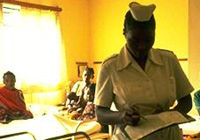 At least 57 countries have a crisis shortage of health workers; 36 of those are in Africa. Photo credits: UNAIDS
At least 57 countries have a crisis shortage of health workers; 36 of those are in Africa. Photo credits: UNAIDSOne of the major constraints to addressing both the AIDS epidemic and global access to essential health care services is the serious shortage of healthcare workers. WHO, UNAIDS and the US President’s Emergency Pan for AIDS Relief (PEPFAR) are launching innovative new guidelines to help strengthen health systems through ‘task shifting’ among the health workforce, at the first ever Global Conference on Task Shifting being held in Addis Ababa from 8-10 January 2008.
‘Task shifting’ is the name given to a process of delegation whereby tasks are moved, where appropriate, to less specialized health workers. By reorganizing the workforce in this way, task shifting presents a viable solution for improving health care coverage by making more efficient use of the human resources already available and by quickly increasing capacity while training and retention programmes are expanded. Several countries are already using task shifting to strengthen their health systems and scale up access to AIDS treatment and care.
The Global Conference on Task Shifting will convene health ministers and other senior government officials, opinion leaders, United Nations agencies and non-governmental organizations from both industrialized and resource-constrained countries.
Addressing the health worker shortage crisis

Feature Story
India: largest-ever gathering of people living with HIV
02 January 2008
02 January 2008 02 January 2008
Over 7,000 people living with HIV came
together in Shilparamam-Hyderabad.
Photo credits: UNAIDS
India hosted its largest ever gathering of people living with HIV in December 2007. Over 7,000 people living with HIV came together in Shilparamam-Hyderabad on 7 December for a special event organized by the Andhra Pradesh State AIDS Control Society (APSACS) with the support of UNAIDS and several other partners. As part of the State’s “Be Bold” campaign, a behaviour change communication initiative, the 2007 convention beat the record crowd of 3,800 people living with HIV at the same venue in December 2006.

Union Minister for Labour and Convenor
of the Parliamentary Forum on AIDS,
Oscar Fernandez, restating commitment to
the 2006 'Hyderabad Declaration'.
Photo credits: UNAIDS
The event brought together a variety of stakeholders to reiterate commitment to reducing stigma, increasing access to services for people living with HIV and to creating an enabling environment for preventing the spread of HIV. It was also an opportunity to restate commitment to the “Hyderabad Declaration”, which was originally signed at the 2006 event.
“It was festive time for people living with HIV. Women participated in the Rangoli competition, children participated in the painting competition and games organized specially for them. Adults also listened to lectures on treatment adherence and precautions against opportunistic infections,” said G. Asok Kumar, Project Director at on of the APSACS. “Such a huge gathering of people living with HIV helped considerably reduce stigma,” he added.

Oscar Fernandez meeting with a number of
the convention participants.
Photo credits: UNAIDS
The event was inaugurated by Oscar Fernandez, the Union Minister for Labour and Convener of the Parliamentary Forum on AIDS (PFA), J.D. Seelam, Co-Convener PFA, Dr Sailajanath, Convener and Shri B. Kamalaker Rao, Co-Convener of Andhra Pradesh Legislators Forum on AIDS among many other Government officials.
The convention reflected on the progress that has been made since the last meeting in 2006. According to State figures, in just a year, the number of people receiving antiretroviral therapy increased from just 2,200 in 2006 to 25,000 in December 2007. The number of people living with HIV accessing health care services has also gone up phenomenally. In the last year more than 600,000 pregnant mothers had an HIV test. The overall number of HIV tests carried out in the state in the last 11 months reached1.5 million, up from 1.3 million tests registered during the whole period from 2000 to 2006.
India: largest-ever gathering of people living wi

Feature Story
Innovative approaches at grassroots level in Zambia
26 December 2007
26 December 2007 26 December 2007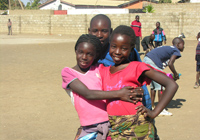
Young people in Zambia.
Photo credits: UNAIDS/M.Aon
Slowing the high rate of new infections in young girls in Zambia is being addressed with urgency by leadership on several levels across the country.
The high rate of infections in young girls is a key element of the epidemic in Zambia. Girls are at risk for several reasons including the fact that hey are often economically dependent on men, or fear violence from them, so however well educated they are about the risks, they cannot say no to sex. In Zambia there is also pressure on women to demonstrate their fertility, so they do not use condoms and a cultural trend for inter-generational relationships also puts girls at risk: statistics show that HIV prevalence peaks in men between the ages of 29 and 34; in women it is 15 – 24.
Addressing this issue, a partnership called “Women for Change” works with traditional leaders in Zambia who are all men, conducting education around relationships in addition to mediation skills in community disputes, for example, over issues about land.
Rainbow Coalition of NGOs targeting HIV and women’s rights
Zambia has also seen the recent founding of the Rainbow Coalition. Its patron, Mrs Elizabeth Mataka is also Executive Director of ZNAN and the United Nations Secretary General’s Special Envoy on AIDS in Africa.
The Rainbow Coalition was founded with the support of the Open Society Initiative for Southern Africa. It has brought together for the first time, diverse NGOs concerned with HIV and women’s rights issues, to bid for Global Fund grants.
Their work has helped to persuade the Global Fund to issue stringent guidelines to recipients of its grants to ensure that they take into account the needs of women and girls equally with men.
Sisonke Msimang, AIDS programme manager at the Open Society Initiative for Southern Africa, says: “It’s absolutely great that through this exercise the Global Fund has reviewed the conditions for awarding grant money in future.
“With modifications in the rules, it should be easier for the Rainbow Coalition to target the grants available from the Global Fund. That’s what we are pushing for now.”
Coordinated partnership key
Recently arrived in Zambia, UNAIDS’ Partnerships Adviser, Maha Aon, says one of her greatest challenges is to learn more about how to make prevention work for girls in a context like Zambia, and to ensure partners are working together for the best results.

About 300 representatives of community-
based organisations, mostly from
district-level, were invited to a national AIDS
conference organized by the Zambia National
AIDS Network (ZNAN).
Photo credits: ZNAN
The issue of women and girls was a central consideration at a national AIDS conference on the role of civil society in the quest for universal access held in Zambia earlier this year.
About 300 representatives of community-based organizations, mostly from district-level, were invited to the conference organized by the Zambia National AIDS Network (ZNAN).
“At the three-day ZNAN conference, there were many discussions on how to ensure different civil society constituencies working in the field organized and nominated representatives to participate at a national level and feed back to their constituencies,” she said.
Through workshops and seminars, they examined the work at grassroots level in prevention, treatment, care and support. They shared their successes and challenges, and debated civil society’s advocacy agenda around human rights issues ranging from gender to working with most-at-risk populations.
“There are many partners working on HIV in Zambia, but the main challenge is to get the programmes and money down to the districts and in a country as vast as Zambia with the poor quality of roads, this is not an easy feat.”
“At UNAIDS we find ourselves advocating for improved road systems, for income generation activities, for a strengthened civil society movement…issues that are key to development in general and not just to the micro-level issue of virus transmission.
“The Zambian government and people’s openness, frankness and sincerity in dealing with development in general, and HIV in particular is absolutely humbling, and the mere presence of this myriad of international partners and development aid make it obligatory for us to work on delivering.”
Innovative approaches at grassroots level in Zamb
Feature stories:
UNAIDS Special Representative Mary Fisher visits Zambia (29 Aug 2007)
Publications:
Zambia UNGASS report English (pdf, 559Kb)

Feature Story
Year in review: UNAIDS in 2007
19 December 2007
19 December 2007 19 December 20072007 has been an exciting year for UNAIDS particularly in the fields of research and monitoring and evaluation. Results from new studies were announced early in the year providing evidence that male circumcision can reduce the risk of HIV infection in men by up to 60%; and new and improved data gathering and methodology was used to produce revised estimates for HIV which showed that the global number of people living with HIV was significantly lower than previous estimates indicated.
Political leaders also stepped up to the table in 2007 with announcements from the G8 leaders of a projected $US 60 billion investment in AIDS, tuberculosis and malaria and a call from the US President to double the current funding for President Bush’s Emergency Plan for AIDS Relief to reach US$ 30 billion over five years.
A number of regional AIDS conference were held in 2007 giving each region an opportunity to put AIDS high on the agenda and examine their epidemics in depth. These conferences also provided a platform for participants to share ideas and strategies for moving the regional AIDS response forward.
Universal access and in particular HIV prevention have been a much talked about topics this year with UNAIDS and partners launching an e-forum on HIV prevention in southern and eastern Africa, the release of the UNAIDS 'Practical Guidelines for Intensifying HIV Prevention', the meeting of the reference group on HIV prevention and a call to intensify HIV prevention, all of which are highlighted in the ‘Year in review’.
Below are some of the highlights and key events which took place in 2007.
| JANUARY | |
| UNAIDS Policy Brief : HIV and Sex between men | |
 | Country and regional consultations have confirmed that stigma, discrimination and criminalization faced by men who have sex with men are major barriers to the movement for universal access to HIV prevention, treatment, care and support. UNAIDS has released a policy brief which outlines recommendations required to try and overcome these barriers. |
| FEBRUARY | |
| Be smart – protect yourself | |
 | German football star and UNAIDS Special Representative Michael Ballack has featured in a public service announcement on AIDS, speaking out on HIV prevention and urging young people to make the smart choices. |
| HIV and refugees | |
 | Conflict, persecution and violence affect millions of people worldwide, forcing them to uproot their lives. Refugees are those who flee their country of origin across national borders, often to a neighbouring country. UNAIDS in collaboration with UNHCR have developed a policy brief that focuses specifically on actions required to prevent and mitigate the effect of HIV on refugees and their host communities. |
| Male circumcision and HIV: a web special series | |
 | Male circumcision is one of the world’s oldest surgical practices; carvings depicting circumcisions have been found in ancient Egyptian temples dating as far back as 2300 BC. New research has produced evidence which shows that circumcision can reduce the risk of HIV infection in men by up to 60%. Read the three part special on HIV and male circumcision. |
| MARCH | |
| UNAIDS releases 'Practical Guidelines for Intensifying HIV Prevention' | |
 | UNAIDS has released Practical Guidelines for Intensifying HIV Prevention: Towards Universal Access to assist policy makers and planners in countries to strengthen their national HIV prevention response. |
| Responsibility and Partnership: Together against HIV/AIDS | |
 | Representatives of 27 European Union and neighbouring countries met in Bremen, Germany to discuss ways of strengthening political leadership in the response to AIDS. Over 600 people attended the 2007 European AIDS Conference which was organised by the German Federal Government in its capacity as current President of the European Union. |
| Together against TB and HIV | |
 | The lethal combination of TB and HIV was highlighted on this year’s World TB Day on 24th March. The weakened immune system caused by HIV makes people living with HIV at greatly increased risk of developing TB disease. TB is a leading cause of death among people living with HIV. UNAIDS, WHO and the Stop TB Partnership have pledged to work together to fight against these deadly viruses. |
| APRIL |
| Treatment figures reach 2 million | |
 | WHO, UNAIDS and UNICEF have launched a new report on scaling up priority AIDS interventions in the health sector. |
| IV Latin American and Caribbean Forum on HIV/AIDS | |
 | The IV Latin American and Caribbean Forum on HIV/AIDS and STD’s opened in Buenos Aires on 17 April under the theme "Latin America and the Caribbean: United in diversity towards universal access". |
| E-forum gets HIV prevention online | |
 | A new electronic discussion forum (e-form) on ‘accelerating HIV prevention’, launched by UNAIDS and partners in southern and eastern Africa, encourages people to get online to debate, share knowledge and build partnerships on HIV prevention issues. |
| MAY | |
| UN General Assembly meets on AIDS | |
 | At the 61st session of the General Assembly, United Nations Secretary-General Ban Ki-moon confirmed his support to the AIDS response promising to ensure that the international community remains united against the epidemic. |
| Injecting drug use: focused HIV prevention works | |
 | Drug users not only face physical risks of HIV infection, they are also vulnerable to HIV because of their social and legal status. Illegal in many countries, drug use is punishable by incarceration and is highly stigmatized, which further marginalizes people with drug dependence problems. As a consequence, injecting drug users are often not able or willing to access HIV services for fear of recrimination. |
 | UN Plus– the UN system-wide group of staff living with HIV– met with the United Nations Secretary-General Ban Ki-moon to brief him on the key achievements of the group since its inception in March 2005 and to discuss the opportunities and challenges and limitations that UN positive staff face at work. |
| UNAIDS welcomes call for $30 billion to the AIDS response | |
 | The Joint United Nations Programme on HIV/AIDS (UNAIDS) applauds the announcement by United States President George Bush regarding his intention to extend and expand the U.S. government’s investment in the global AIDS response. |
| HIV testing and counselling: new guidance | |
 | WHO and UNAIDS issued new guidance on informed, voluntary HIV testing and counselling in the world's health facilities on Wednesday 30 May, with a view to significantly increasing access to needed HIV treatment, care support and prevention services. |
| JUNE |
| Scaling up through partnerships | |
 | Donors, AIDS experts and implementers from around the world have gathered in Kigali, Rwanda to attend the 2007 HIV/AIDS Implementers’ Meeting. |
| JULY | |
| Call to intensify HIV prevention | |
 | In a new report released on HIV prevention, a panel of leading AIDS experts calls for a major increase in global HIV prevention programs, citing new projections that expanded access to prevention could avert approximately 30 million of the 60 million HIV infections expected to occur by 2015. |
| 2.5 million people living with HIV in India | |
 | As part of its continuous efforts to know its epidemic better, India’s National AIDS Control Organisation, supported by UNAIDS, has used data from the expanded surveillance system and a new population-based survey to produce more accurate estimates of the AIDS epidemic in India. |
| AUGUST | |
| Hope for street children | |
 | Street children in Cairo, are at a far higher risk of exposure to HIV than children who have a stable home life. Workers at the Hope Village Society, an organisation looking after Cairo’s street children, have been working with UNICEF and UNAIDS to incorporate AIDS awareness in their educational programmes. |
| New Blog gets HIV science online | |
 | For the latest news, views and reviews on HIV coverage in the scientific literature – log on to HIV this week! |
8th International congress on AIDS in Asia and the Pacific | |
 | The 8th International Congress on AIDS in Asia and the Pacific (ICAAP) took place in Colombo, Sri Lanka on from 19 - 24 August. The conference brought together more than 3,000 delegates from around 60 countries to discuss critical issues on AIDS in the region such as stigma and discrimination, access to HIV prevention and treatment and the importance of sustained political commitment on AIDS. |
| The process behind AIDS estimates | |
 | As part of continuing efforts to gain a better understanding of the AIDS epidemic, UNAIDS and WHO have taken a series of measures to improve the estimation process. Countries have been encouraged to expand their data collection methods, methodology used to analyse this new data has been improved and a series of workshops have been held to train people in countries in the complex process of estimating the AIDS epidemic. This process is resulting in more concise estimations and a better understanding of how epidemics are evolving. |
| SEPTEMBER | |
| Promoting sport and HIV prevention | |
 | ”LoveLife, together with the ICC, UNAIDS, UNICEF and the Kaiser Family Foundation, have joined together in a unique partnership to highlight the situation of children and young people living with and affected by HIV through the global game of cricket. |
| Financial resource requirements for AIDS | |
 | UNAIDS has produced a new report on the estimated financial resources required for the AIDS response to achieve the goal of universal access to HIV prevention, treatment, care and support. |
| OCTOBER | |
| Progress and challenges for Botswana | |
 | In a joint mission, UNICEF Executive Director Ann Veneman, UNAIDS Executive Director Peter Piot and Dr Tadatakai Yamada, President of the Bill & Melinda Gates Foundation’s Global Health Programme visited Botswana to gain a shared perspective of the progress and challenges facing the country in its AIDS response. |
| “Overwhelming and Inspiring” | |
 | Rupert Everett, the film and theatre actor (My Best Friend’s Wedding, Another Country), and Special Representative of UNAIDS visited Moscow and St Petersburg 23 – 26 September, to learn more about AIDS and tuberculosis in Russia and to help raise awareness about these two important, inter-linked diseases. |
| NOVEMBER | |
| CONCASIDA 2007 | |
 | The 5th Central American Congress on HIV was held in Managua, Nicaragua, from 4-9 November. Over 1,500 participants attended the Congress including representatives from governments, the United Nations, people living with HIV, women’s organizations, religious groups and the private sector. |
| Concern over Criminalization of HIV Transmission | |
 | Several countries have recently introduced laws to criminalise HIV transmission, or exposing another person to the virus. A number of jurisdictions have used general laws against serious bodily harm in cases where someone is accused of knowingly transmitting HIV or willingly exposing others to HIV transmission. |
First Global Parliamentary Meeting on AIDS | |
 | The First Global Parliamentary Meeting on HIV/AIDS was opened on Wednesday 28 November in Manila by Mr Manny Villar, President of the Senate of the Philippines. UNAIDS Deputy Executive Director, Michel Sidibe gave one of the key note speeches, highlighting the important role parliamentarians have to play in the global response to the epidemic. |
| AIDS on the agenda at Commonwealth Heads meeting | |
 | UNAIDS Deputy Executive Director Deborah Landey visited Kampala, Uganda from 16-17 November. In addition to meeting with various leaders in Uganda’s AIDS response from government and civil society, Dr Landey participated in a plenary session at the Commonwealth Heads of Governments Meeting (GHOGM), which was taking place in Kampala during her visit. |
| International consultation on AIDS estimates: Recommendations | |
 | An International Consultation on AIDS Epidemiological Estimates, convened jointly by the UNAIDS Secretariat and WHO, was held on 14-15 November 2007 in Geneva, Switzerland. The meeting brought together more than 30 technical experts and country epidemiologists from around the world to review the current processes and methodologies used by UNAIDS and WHO to produce HIV estimates at the country, regional and global level. |
| AIDS epidemic update 2007 | |
 | The 2007 AIDS epidemic update reports on the latest developments in the global AIDS epidemic. The 2007 edition provides the most recent estimates of the AIDS epidemic and explores new findings and trends in the epidemic’s evolution. |
| DECEMBER | |
| World AIDS Day 2007 | |
 | This year's World AIDS Day theme – leadership – reminds us that, from government leaders to individuals, we all have a leadership role to play in the AIDS response and we are all accountable for the promises made. On 1 December UNAIDS participated in events around the globe to commemorate this special day of remembrance and hope. |
| Meeting ethical concerns over HIV trials | |
 | In the first of a special three-part web series, www.unaids.org looks at the state of research into new HIV prevention technologies, the ethical debates around the issue, and the steps that have been taken to answer the concerns. The question of HIV trials, and in particular the involvement of women and adolescent girls in them, will be the subject of a two-day conference being hosted by UNAIDS in Geneva December 10-11. |
| More than words: ART for AIDS | |
 | World AIDS day 2007 marked the first anniversary of the UNAIDS’ Art for AIDS collection—an art collection created to recognize the role art has played in the response to AIDS. In a special three-part series, www.unaids.org tells the story of the collection, and the artists who helped create it. |
| Updated look and enhanced features for www.unaids.org | |
 | Welcome to the refreshed UNAIDS web site! We are delighted to introduce a new-look design, restructured navigation for the site and a host of new features including a live newsfeed from UNAIDS Cosponsors, the new ‘Knowledge Centre’ and the new ‘Multimedia Centre’. We hope this enables you to find the information you need more easily. We invite you to browse the refreshed site and welcome your feedback. |
Related
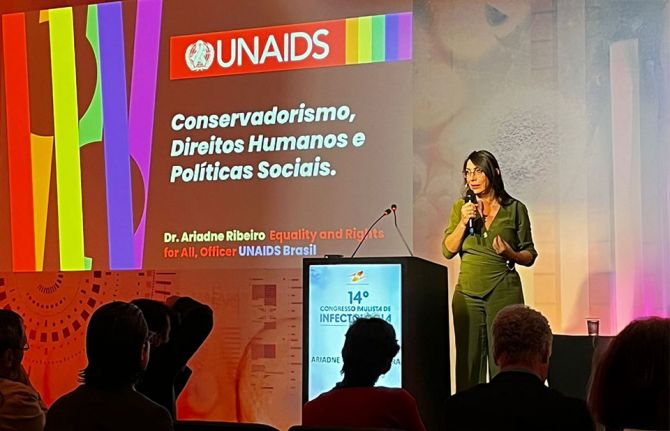 Upholding dignity for everyone: Ariadne Ribeiro Ferreira
Upholding dignity for everyone: Ariadne Ribeiro Ferreira

21 November 2024

Feature Story
UN special session follow-up: A World Fit for Children +5
18 December 2007
18 December 2007 18 December 2007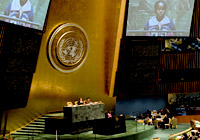
© UNICEF/HQ07-2010/Markisz
The declaration adopted by the General Assembly identified poverty eradication as the greatest global challenge facing children.
The commemorative high level plenary meeting devoted to the follow-up to the outcome of the United Nations special session held in 2002 has ended with the adoption of a new Declaration on Children which reaffirms the commitments laid out five years ago.
On 13 December 2007 more than 140 government delegations adopted the Declaration which addresses improving the lives of children.
In addition to Heads of State and government, some 130 high level national delegations gathered at United Nations Headquarters for the landmark conference to review progress on the ‘A World Fit for Children’ plan of action created by governments in 2002.
Twenty children participated in the plenary as members of their national delegations. Hundreds of NGOs also gathered in New York for discussions and advocacy on children’s issues.
 © UNICEF/HQ07-1930/Susan Markisz
© UNICEF/HQ07-1930/Susan Markisz Ann M. Veneman (centre) with (left to right) Committee on the Rights of the Child Chair Dr. Yanhee Lee, UNAIDS Executive Director Dr. Peter Piot, Professor Ernesto Schiefelbein and Plan International Regional Director Dr. Deepali Khanna.
The day before the opening of the plenary, UNICEF released a new report—‘Progress for Children: A World Fit for Children Statistical Review’—on how well the world is doing in meeting its commitments for the world.
This report analyses progress towards the Millennium Development Goals in four priority areas for children: promoting healthy lives, providing a quality education, responding to AIDS, and protecting against abuse, exploitation and violence.
“This is the most comprehensive ‘Progress for Children’ report to date,” UNICEF Executive Director Ann M. Veneman told participants in a Town Hall meeting at UNICEF House on 10 December.
The open forum featured a panel of experts, including UNAIDS Executive Director Peter Piot and Yanhee Lee of the Committee on the Rights of the Child.
Also present were representatives of over 50 non-governmental organizations, who were encouraged to comment on the report and share their experiences in working in a wide range of programmes for children. Young delegates to this week’s UNICEF-sponsored Youth Forum also joined the discussion.
Right Hand Content
Cosponsors:
Read UNICEF reports on the ‘World Fit For Children + 5’ plenary
Publications:
Declaration of the commemorative high-level plenary meeting devoted to the follow-up to the outcome of the special session on children
Progress for Children: A World Fit for Children Statistical Review (December 2007)

Feature Story
Updated look and enhanced features for www.unaids.org
14 December 2007
14 December 2007 14 December 2007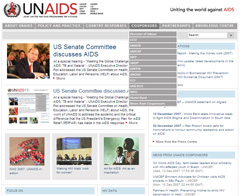
UNAIDS website new-look homepage, 14 December 2007
Welcome to the refreshed UNAIDS website!
UNAIDS is delighted to introduce a new-look design, restructured navigation for the site as well as and many rich new features including a live Cosponsor newsfeed, a new ‘Knowledge Centre’ and ‘Multimedia Centre’ and improved navigation menu. We hope this combination of enhanced functionality and usability will improve the web visitor’s experience.
The goal is to make it easier for all visitors—including advocates, policymakers, practitioners, the media, researchers and community members—to find information on AIDS and the work of UNAIDS and its Cosponsors through the web site. It will also make it easier to access key technical resources, learn about our partnerships and keep up-to-date on the latest UNAIDS news.
New features
Several new features including a new-look homepage with dropdown navigation menus, a live Cosponsor newsfeed, a new ‘Knowledge centre’ which houses all UNAIDS key data and resources and a new-look publications section and multimedia centre housing video, audio and photographic materials
Annemarie Hou, Chief of Communications and Knowledge Sharing, said: “Our aim has been to make the web site more intuitive, more comprehensive and to reduce duplication of material.”
“The launch of the new Knowledge Centre signals UNAIDS role as a go-to source for information about the epidemic and offers enhanced knowledge sharing to our partners and other stakeholders.”
We invite you to browse the new site and very much welcome your feedback. You can contact us with your ideas and suggestions by email: webmaster@unaids.org.
Related

Feature Story
US Senate Committee discusses AIDS
13 December 2007
13 December 2007 13 December 2007
UNAIDS Executive Director Dr Peter Piot address US Senate Committee
At a special hearing - "Meeting the Global Challenge of AIDS, TB and Malaria" - UNAIDS Executive Director Dr Peter Piot addressed the US Senate Committee on Health, Education, Labor and Pensions (HELP) about AIDS, the work of UNAIDS to address the epidemic and the critical difference that the US President's Emergency Plan for AIDS Relief (PEPFAR) has made in the AIDS response.
Also addressing the Committee in Panel I were U.S. Global AIDS Coordinator, Ambassador Mark Dybul and Director of the US Centers for Disease Control and Prevention. Joining Dr Piot in Panel II were World Vision HIV educator Princess Zulu, Professor of the University of California, Dr Norman Hearst and Vice Chair of the IOM Evaluation Committee, Dr Helen Smits.
Resources:
Read written testimony provided by UNAIDS Executive Director Dr Piot to the US Senate committee on Health, Education; Labor and Pensions (HELP)
Read follow up questions submitted by HELP to Dr Piot
External links:
More on 'Meeting the Global Challenge of AIDS, TB and Malaria' - US Senate Committee web site
View the hearing


